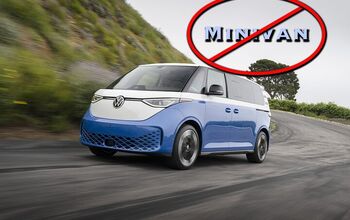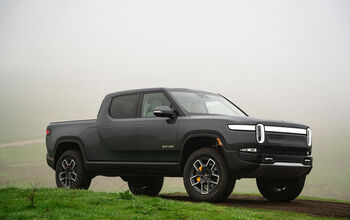Top 10 Automotive Failures Carmakers Hoped You Forgot About

In its 100-plus years, the automotive industry has delivered plenty of superb vehicles.
But for each grand slam, there are many more strike outs, whether it’s a brand, nameplate or even a technology. Here’s a list of 10 automotive failures that we’re sure carmakers hoped you forgot about.
10. Pontiac Aztek
We start this list with something obvious, a fetid piece of low-hanging fruit, Pontiac’s Aztek. The butt of more jokes than North Korea’s Kim Jong-un, this minivan-based “sport-recreational vehicle” has been out of production for more than decade, yet it remains a cultural touchstone synonymous with vomitus design. The Aztek is a low watermark in so many ways, a physical embodiment of everything wrong with this industry.
9. Chrysler Airflow
That Pontiac Aztek is hardly the first car that caused people to recoil in disgust. Back in the 1930s, Chrysler developed a revolutionary new car that was chockablock with innovation, yet its styling kept drivers at bay like the promise of catching polio. Their Airflow lineup was literally decades ahead of its time. Bodies were sleek and refined in a wind tunnel, they featured a unique chassis arrangement that improved weight distribution for better ride and handling, and they even benefited from a full-steel unibody at a time when rivals were still using structural wood. But the Airflow’s controversial styling turned customers away and Chrysler pulled the plug on this project just a few years after it began. ‘Tis a shame; I’d love to park an Airflow in my garage.
SEE ALSO: Top 10 Defunct Auto Brands
8. Yugo
This one needs little explanation. The Yugo was a laughably failed experiment in bringing a new class of cheap car to the American market. Zastava, the manufacturer, likened this little hatchback to the Volkswagen Beetle and Ford Model T in some of its advertisements, promising an inexpensive, no-frills vehicle. Regrettably, the Yugo’s abhorrent quality and miserable driving experience meant it was mercifully short-lived in the United States. But do you really expect more from a license-built Fiat assembled in the Balkans during communism’s reign?
7. The Cadillac V8-6-4
Not every epic automotive failure is actually a vehicle. There have been plenty of technological flops as well. Case in point, Cadillac’s V8-6-4 engine. Released in early 1980s, this powerplant promised eight-cylinder performance with dramatically improved fuel efficiency. The idea behind this was ingeniously simple; just “turn off” extra cylinders when they’re not needed. What a brilliant idea! However, in practice, this never actually worked. Internally referred to as the L62, its computer controls were simply too primitive to ever deliver an enjoyable experience. Stalling and bucking were commonplace drivability issues that made this engine unbearable. Many owners simply had the cylinder-deactivation system disabled, so the car ran as a V8 all the time. Voila, problem solved!
6. Ford Pinto
The Ford Pinto is a legendary automotive failure, even if it isn’t necessarily an abjectly terrible car. As homely to the eye as it was depressing to drive, the biggest issue with this malaise-era compact model was its allegedly explosive fuel tank. When hit from behind, they tended explode like a hand grenade thanks to fuel tanks that were mounted behind the rear axle. Whether the Pinto was any less safe than other cars of the era is debatable, but the ensuing legal controversy broke this horse’s legs and Ford euthanized it by 1980.
5. Tucker
Have you ever heard of Tucker? It was an up-and-coming automaker in the late 1940s that tried to introduce a revolutionary new automobile. The Tucker 48 featured countless innovations including a padded dashboard and pop-out windshield for greater safety, a rear-mounted flat-six aircraft engine, four-wheel independent suspension and much more. But for all of its advancements, some questionable business practices led to an investigation by the Securities and Exchange Commission, which was ultimately this firm’s undoing. Only about 50 cars were built. Think of Tucker as a Fisker from half a century ago. Hell, they both have six letters in their names and end in “ker.” Talk about history repeating itself.
4. MyFord Touch
Fast-forward to the 21st century and electronics are all that seem to matter. A whole generation has been brought up on the Internet, practically born with smartphones in their hands. The Blue Oval was an early leader in the infotainment race, integrating voice controls and finger-friendly screens in many vehicles. However, its MyFord (and MyLincoln Touch) system was almost universally derided for being slow, finicky and downright unreliable. In fact, this system singlehandedly torpedoed the brand’s ratings in several quality studies, something it still hasn’t recovered from.
3. Dex-Cool
Another recent automotive failure involves something as simple as antifreeze. For years, GM filled its vehicles with Dex-Cool, a bright orange, tasty-looking coolant that supposedly has an extra long life, up to five years or 150,000 miles. Unfortunately, over time and often waaaaay before its recommended service interval, this stuff goes south, transforming into a rusty brown sludge that clogs radiators and inhibits cooling. But that’s not the real issue. It also starts to attack engine components, leading to myriad issues. If you own a GM vehicle built after about 1996, it’s prudent to flush the cooling system every year or two to sidestep financial ruin.
2. Oldsmobile Diesel
Oldsmobile is long gone, but memories of its infamous diesel engine won’t be forgotten. This oil-burning powerplant was GM’s shortsighted response to rising gasoline prices in the late 1970s. But the quality of this compression-ignition V8 was horrendous. If any water got in the fuel, it would corrode the injection system, blocks castings were questionable at best, and inadequate cylinder-head design caused gaskets to blow like the wind. When running properly, these engines were economical in their day, but the reliability was so atrocious they didn’t just damage their manufacturer’s reputation, but the image of all diesel engines.
1. Edsel
Finally, we come to our No. 1 automotive failure, the biggest vehicular blunder in history, and it’s called Edsel. Designed by Ford to help win sales and market share from General Motors and other rivals, this ill-conceived division cost the company untold millions of dollars (billions at today’s exchange rate). Instead of a showroom success, it rapidly became a textbook example of corporate incompetence. In short, they tried to launch a strangely styled, poor-quality vehicle with an unclear position in the marketplace during an economic recession. That has success written all over it! In no uncertain terms, Ford’s Edsel project was an unmitigated disaster.
Check out our other Top 10 Lists!

Born and raised in metro Detroit, Craig was steeped in mechanics from childhood. He feels as much at home with a wrench or welding gun in his hand as he does behind the wheel or in front of a camera. Putting his Bachelor's Degree in Journalism to good use, he's always pumping out videos, reviews, and features for AutoGuide.com. When the workday is over, he can be found out driving his fully restored 1936 Ford V8 sedan. Craig has covered the automotive industry full time for more than 10 years and is a member of the Automotive Press Association (APA) and Midwest Automotive Media Association (MAMA).
More by Craig Cole










































Comments
Join the conversation
Pontiac Azzcrack and Dex-Cool are just some reasons GM should have been allowed to fail
Agree with MyFord Touch on this list. Honorable mention should go to early GM 700R4 transmissions. They had early failures. The rebuilds also failed early. In a few years we can add the ZF 9spd transmissions. The ZF 9spd is terrible in just about everything (Acura, Land Rover, Jeep Cherokee, Honda Pilot).